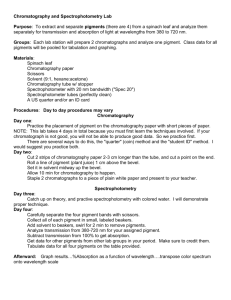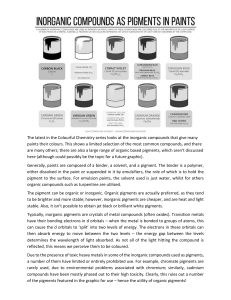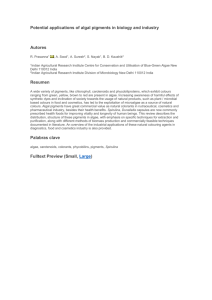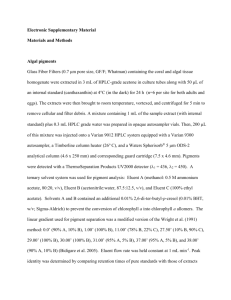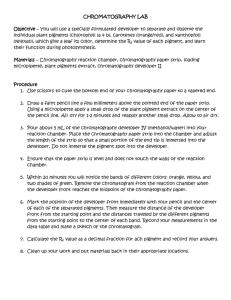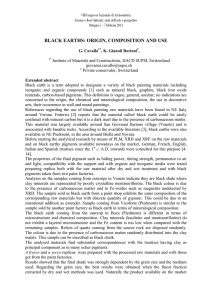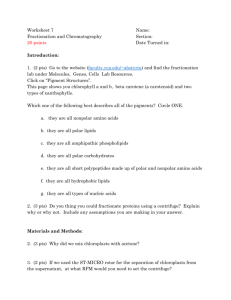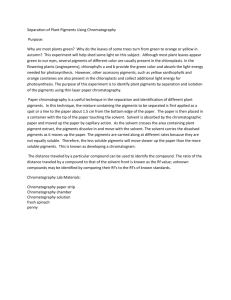toxicological decomposition
advertisement
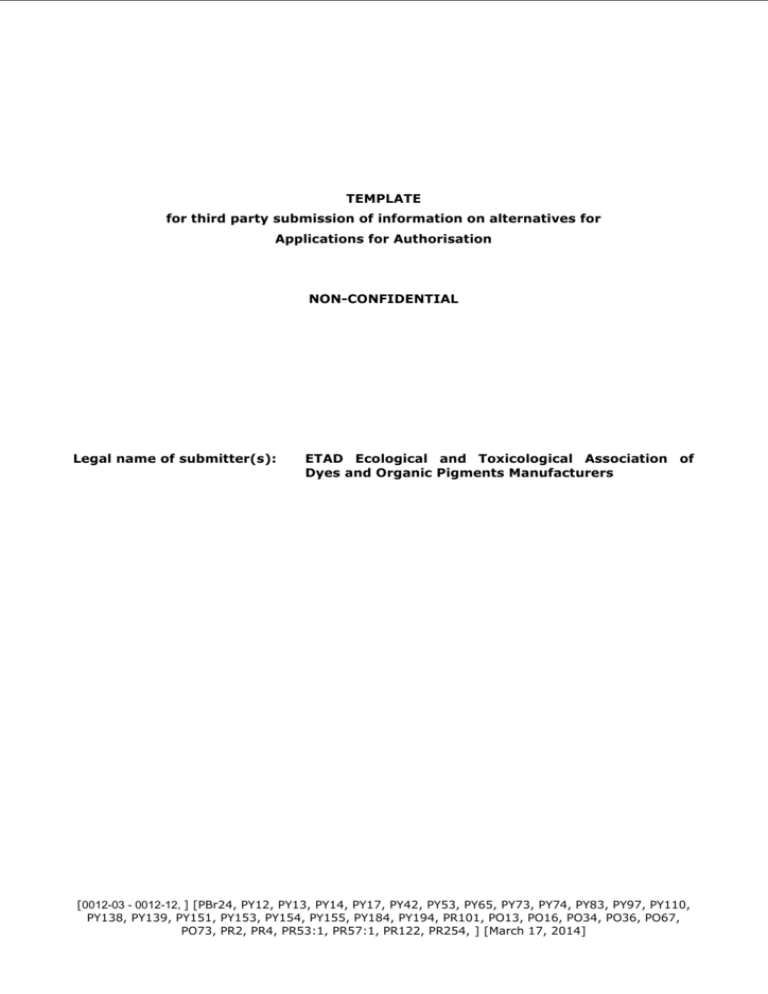
Submission of informat ion on TEMPLATE for third party submission of information on alternatives for Applications for Authorisation NON-CONFIDENTIAL Legal name of submitter(s): ETAD Ecological and Toxicological Association of Dyes and Organic Pigments Manufacturers [0012-03 - 0012-12, ] [PBr24, PY12, PY13, PY14, PY17, PY42, PY53, PY65, PY73, PY74, PY83, PY97, PY110, PY138, PY139, PY151, PY153, PY154, PY155, PY184, PY194, PR101, PO13, PO16, PO34, PO36, PO67, PO73, PR2, PR4, PR53:1, PR57:1, PR122, PR254, ] [March 17, 2014] SUBMISSION OF INFORMATION ON ALTERNATIVES (NON-CONFIDENTIAL) TABLE OF CONTENTS 1. ALTERNATIVE ID AND PROPERTIES ......................................................................... 3 2. TECHNICAL FEASIBILITY ........................................................................................ 3 3. ECONOMIC FEASIBILITY ......................................................................................... 3 4. HAZARDS AND RISKS OF THE ALTERNATIVE............................................................. 3 5. AVAILABILITY ....................................................................................................... 9 6. CONCLUSION ON SUITABILITY AND AVAILABILITY OF THE ALTERNATIVE .................... 9 7. OTHER COMMENTS ................................................................................................ 9 REFERENCES ............................................................................................................ 9 APPENDIXES ............................................................................................................. 9 [0012-03 - 0012-12, ] [PBr24, PY12, PY13, PY14, PY17, PY42, PY53, PY65, PY73, PY74, PY83, PY97, PY110, PY138, PY139, PY151, PY153, PY154, PY155, PY184, PY194, PR101, PO13, PO16, PO34, PO36, PO67, PO73, PR2, PR4, PR53:1, PR57:1, PR122, PR254, ] [March 17, 2014] 2 SUBMISSION OF INFORMATION ON ALTERNATIVES (NON-CONFIDENTIAL) 1. ALTERNATIVE ID AND PROPERTIES [Insert text here] 2. TECHNICAL FEASIBILITY [Insert text here] 3. ECONOMIC FEASIBILITY [Insert text here] 4. HAZARDS AND RISKS OF THE ALTERNATIVE With regard to the described hazards of the alternative substances we have a different view. Colorant producers present on the international market and with manufacturing sites worldwide already submitted to ECHA REACH dossiers on most organic pigments discussed as alternatives. Based on the current knowledge of the substances and of the manufacturing processes such alternative colorants have a less problematic toxicological profile compared to lead chromates. The comments can be found in various similar documents (0012-05, 0012-06, 0012-09, 001210,0012-11,0012-12). The page number may vary. 4.1 DIARYLIDE PIGMENTS – DIARYLIDES – ALTERNATIVE 3 No. Page No. 28 32 Quote Production of semi-products is very dangerous and pollutive. When breaking down into constituent parts the pigments yield dangerous classified substances. Limitations for these releases have already been set in European legislation for example for food packaging. 48 53f 58f In Appendix 1 we have given an overview of warnings from market suppliers (excluding the applicant) regarding the various alternatives. These warnings and independent research generally support the views below which are the summarised opinion of the applicant regarding the risks Comment The production can take place mainly in closed systems, i.e. occupational exposure can be excluded. Additionally, through appropriate waste treatment, these organic semi-products can be decomposed to toxicological harmless compounds. The thermal degradation of azo diarylide pigments in polymers is a long known issue. A corresponding publication from ETAD clarified already in 1990 under which conditions the breakdown occurs, with specific references to the different applications. The document is a well-known reference also outside the association. Non-classified pigment grades of PO. 34, PY. 13 and PY. 83 are available on the market. Experimental data on all four pigments has been collected and generated for the purpose of registration under REACH at the tonnage band of > 1000 tpa (PY. 13 and PY. 13) and 100/1000 tpa (PO. 34, PO. 13). [0012-03 - 0012-12, ] [PBr24, PY12, PY13, PY14, PY17, PY42, PY53, PY65, PY73, PY74, PY83, PY97, PY110, PY138, PY139, PY151, PY153, PY154, PY155, PY184, PY194, PR101, PO13, PO16, PO34, PO36, PO67, PO73, PR2, PR4, PR53:1, PR57:1, PR122, PR254, ] [March 17, 2014] 3 SUBMISSION OF INFORMATION ON ALTERNATIVES (NON-CONFIDENTIAL) of the alternatives in this group.… - Some of the pigments in the group are classified as carcinogenic due to impurities (PO.34), or have MSDS warnings of being sensitisers (PO. 13, PO. 34) or causing other toxic effects (PY.13, PY.83); In general, all four pigments are not toxic upon acute ingestion, not irritating to skin and eyes and do not cause skin sensitization in experimental animals. No adverse effect after repeated exposure, no genotoxicity or reproductive toxicity was observed. The pigments are not considered to be carcinogenic and no hazard for the environment was identified. As regards the specific warnings: (PO34): Carcinogenic due to impurities - This description is based on a MSDS from CHEMTREC, as written on P110. These impurities are described as carbon black and ethylbenzene. These impurities are not mentioned in the entries for PO34 REACHregistration, and no corresponding classification is triggered for the registered products. (PO 13, PO 34): warning of being sensitisers This description is based on MSDS from Lansco Colour (PO 13) and from CHEMTREC, as written on P 109 and 110, respectively. See general comment above. Additionally, concerning PO34 the above mentioned MSDS says “May cause silicosis due to crystalline silica presence.” This implies that the toxic effect is caused by silica and not by PO34. (PY13, PY83): causing other toxic effects Concerning PY13, there are no such descriptions in Annex 1 P109-117. It might be a typo. Concerning PY83, the MSDS from CHEMTREC, P 116, says “May be fatal to swallow and long term exposure may cause permanent brain and nervous system damage + may cause corrosion / irritation.” This MSDS contradicts the above information submitted for REACH, a CHEMTREC product-specific classification is a possible explanation. In particular, PY83 showed no specific target organ toxicity, either by single or by repeated exposure. 48 54 59 There is already primary legislation regarding the release Primary Aromatic Amines (3-3’ dichlorobenzidine) setting a limit in plastics that is already hard to meet but in coatings there is no residue over 10 ppb permitted There are grades of PY 83 available which meet the requirements of Resolution AP (89) 1 on the use of colorants in plastic materials coming into contact with food. Among others this Resolution sets a limit for primary aromatic amines (including 3-3'dichlorbenzidine) of < 500 ppm for pigments. This requirement for the pigment will result in a negligible exposure through potential migration from the coloured plastic material. 48 54 59 …The intermediate factory needs to be a so-called ATEX facility– ergo constructed to deal with explosives and considering how many accidents are still occurring, this problem is not theoretical and world-wide production of diarylide pigments causes much more immediate damage than PY.34 and PR.104. The production can proceed safely by using suitable equipment and following safe handling procedures. …Due to the health hazards of the precursor DCB, the manufacture is mandatorily happening in closed systems Even in China or in India, safe production can be achieved by using suitable equipment and following safe handling procedures. 48 54 59 Accidental explosions have been reported in the past, but, to the best of our knowledge, due to mistakes occurred during production. [0012-03 - 0012-12, ] [PBr24, PY12, PY13, PY14, PY17, PY42, PY53, PY65, PY73, PY74, PY83, PY97, PY110, PY138, PY139, PY151, PY153, PY154, PY155, PY184, PY194, PR101, PO13, PO16, PO34, PO36, PO67, PO73, PR2, PR4, PR53:1, PR57:1, PR122, PR254, ] [March 17, 2014] 4 SUBMISSION OF INFORMATION ON ALTERNATIVES (NON-CONFIDENTIAL) with full PPE for personnel – of course in India and China (which are the main sources) this requirement is rarely fulfilled 4.2 No. 48 54 59 …Azo substances are also known to degrade into the environment under slightly acidic conditions – the higher the acidity the faster the degradation. Diarylides pigments do not show such tendency, as reported in many available publications and specifically addressed by the corresponding endpoints in their REACH registrations. 48 54 59 …There is already primary legislation regarding the release Primary Aromatic Amines (3-3’dichlorobenzidine) setting a limit in plastics that is already hard to meet but in coatings there is no residue over 10 ppb permitted. The Resolution AP (89) 1 on the use of colorants in plastic materials coming into contact with food sets a limit for primary aromatic amines (including 33'dichlorbenzidine) of < 500 ppm for pigments. This requirement for the pigment will result in a negligible exposure through potential migration from the coloured plastic material. 48 54 59 …The increased use of the xylene solvent is also an issue that contributes to the environmental and human exposure to hazardous substances. This illustrates that shifting to diarylides is not benificial. Production processes exist where very little xylene is used for diarylide pigments and in particular no xylene is used for the diarylides pigments used as lead chromium substitutes. 48 54 59 …Furthermore diarylides are known to generate carcinogenic by-products during their Decomposition. The thermal degradation of azo diarylide pigments in polymers is a long known issue. A corresponding publication from ETAD clarified already in 1990 under which conditions the breakdown occurs, with specific references to the different applications. The document is a well-known reference also outside the association. ORGANIC PIGMENTS - DIANISIDINE – ALTERNATIVE 4 Page No. 54 61 Quote 55 61 …Azo substances are also known to degrade into the environment under slightly acidic conditions – the higher the acidity the faster the degradation; there is evidence that humans may metabolise the Azo substance to its carcinogenic parent compound. Diarylide pigments do not show such tendency, as reported in various available publications and specifically addressed by the corresponding endpoints in REACH registrations dossiers of diarylide pigments. Organic pigments in general, due to their high insolubility, share the same lack of bioavailability. 55 61 …When the pigment degrades – which it does very easily due to its poor durability – it will release its carcinogenic molecules – unlike the PY.34 and PR.104 molecules that are poorly soluble these ones are soluble and very dangerous. See comment above. 61 x …There is already primary legislation regarding the release Primary Aromatic Amines (3,3’-dichlorobenzidine ) setting a limit in plastics that is already hard to meet but in coatings there is no residue The Resolution AP (89) 1 on the use of colorants in plastic materials coming into contact with food sets a limit for primary aromatic amines (including 33'dichlorbenzidine) of < 500 ppm for pigments. …The intermediate used in the manufacture of these pigments is 3,3’dianisidine is presumed to have carcinogenic potential for humans. The manufacture is mandatorily happening in closed systems with full PPE for personnel. In India and China (which are now almost the only sources) this requirement is rarely fulfilled. Comment Even in China or in India, production can be achieved safely by using suitable equipment and following safe handling procedures. Additionally, even if more soluble in comparison with lead chromates, PO16 still is a quite insoluble substance. [0012-03 - 0012-12, ] [PBr24, PY12, PY13, PY14, PY17, PY42, PY53, PY65, PY73, PY74, PY83, PY97, PY110, PY138, PY139, PY151, PY153, PY154, PY155, PY184, PY194, PR101, PO13, PO16, PO34, PO36, PO67, PO73, PR2, PR4, PR53:1, PR57:1, PR122, PR254, ] [March 17, 2014] 5 SUBMISSION OF INFORMATION ON ALTERNATIVES (NON-CONFIDENTIAL) over 10 ppb permitted. This requirement for the pigment will result in a negligible exposure through potential migration from the coloured plastic material. 54 61 …PO. 16 is itself sometimes noted as a suspected human carcinogen; PO 16: 61 x …The increased use of the xylene or other solvent is also an issue that degrades the environment/health benefit of shifting to diasinides. Production processes exist where xylene is not used in the PO 16 production. Experimental data on acute and subacute toxicity in rats as well as genotoxicity has been made public by MHLW Japan. The acute oral toxicity (OECD 401) was found to be greater than 2000 mg/kg bw and no mortality occurred. No adverse findings were observed in the subacute oral study at the limit dose (OECD 407). PO 16 did not cause genotoxicity in the Ames test with Prival modification for azo compounds (OECD 471) and in the chromosome aberration test in vitro (OECD 473). All studies were reported to be performed under GLP. 4.3 ORGANIC PIGMENTS – AZO BENZIMIDAZOLONES – ALTERNATIVE 5 4.4 ORGANIC PIGMENTS – MONOAZO – ALTERNATIVE 6 4.5 ORGANIC PIGMENTS – SPECIALTY AZO – ALTERNATIVE 7 4.6 ORGANIC PIGMENTS – OTHER ORGANICS – ALTERNATIVE 8 No. 4.7 No. Page No. 80 94 101 Quote PY. 110 and PY. 138 both have extremely dangerous production with intermediate products required that are unstable or solvents that are toxic. In the case PY.110 it is the use of PCl in manufacture and the need to use dangerous solvents dichlorobenzene (Carcinogen cat. 2), POCl3 or trimethylbenzene (causes chronic solvent induced encephalopathy). Furthermore 1,4 - Benzenediamine and Tetrachlorophthalic anhydride both substances dermal sensitiser and known cause of occupational asthma are used as an intermediate in the production of PY.110… Comment Safe production can be achieved by using suitable equipment and following safe handling procedures. DPP PR. 254 – ALTERNATIVE 9 Page No. 82 97 103 Quote Comment …The manufacture is done as follows:… The synthesis steps provided do not reflect a scientific sound manufacturing process for PR 254. A suitable reference can be found, e.g., in “Industrial Organic Pigments, W. Herbst, K. Hunger (Second Edition), VCH”. [0012-03 - 0012-12, ] [PBr24, PY12, PY13, PY14, PY17, PY42, PY53, PY65, PY73, PY74, PY83, PY97, PY110, PY138, PY139, PY151, PY153, PY154, PY155, PY184, PY194, PR101, PO13, PO16, PO34, PO36, PO67, PO73, PR2, PR4, PR53:1, PR57:1, PR122, PR254, ] [March 17, 2014] 6 SUBMISSION OF INFORMATION ON ALTERNATIVES (NON-CONFIDENTIAL) 85 101 107 The production of DPP is very dangerous due to the acids needed in the production…. The production of DPP is mainly conducted under alkaline conditions. To our knowledge, acids are used only for neutralization and the process can be performed under controlled conditions. 4.8 ALTERNATIVES PROPOSED BY SWEDEN IN ITS RESTRICTION PROPOSAL – ALTERNATIVE 10 No. Page No. 86 102 109 Quote There are no known toxicity studies for this substance but the MSDS sheet advises the use of respirators and personal protective equipment due to possible skin sensitisation97. Furthermore PR.2 is mainly manufactured in China – all known sources are heavily contaminated with PCBs and deemed so hazardous that no western manufacturers wishes to use the pigment. 88 103 111 …Pigment Red 57……The substance is a known respiratory and skin sensitizer according to the risk statements that accompany it. 88 103 112 Pigment Red 122…The production of this pigment is also highly pollutive with 5-8 kg of phosphates emitted to surface waters for every 1 kg of pigment produced. C.I. Pigment Yellow 12 …The substance is dangerous when in the presence of strong oxidizing agents and explosive. 104 Comment PR 2 has been registered for REACH, and the pigment dossier contains key toxicity studies as well as supporting studies and read-across references. The skin sensitisation labelling is also based on the evaluation of existing data. No other toxicity is supported by the provided studies. Accordingly to its REACH dossier in the >1000 tpa range, the pigment was registered in Europe by seven companies, most of them present on the international market and with manufacturing sites worldwide. It is also manufactured by other companies with the same profile. Independently from the production site, PR 2 grades are available which will comply with Resolution AP(89)1. In general, non-classified pigment grades of PR 2 are commercially available; these grades show PCBs contents below 50 ppm; specific grades with PCBs contents below 25 ppm are available as well. PR 2 is widely used in Europe, mainly for printing ink applications. PR57:1 Experimental data has been collected and generated for the purpose of registration under REACH at the tonnage band of > 1000 tpa. Pigment Red 57:1 is not toxic upon acute ingestion, skin contact and inhalation. It is not irritating to skin and eyes and does not cause skin sensitization in experimental animals. A screening study for subacute toxicity and repeated dose and reproductive toxicity showed adverse effects on the kidney at high doses. The pigment is a complex between an organic acid and calcium and dissociates at extreme pH, such as present in the stomach. Therefore, solubility is higher than for other pigments and uptake after ingestion is observed. The analogue sodium salt (Pigment Red 57) did not cause adverse effects in a life-long feeding study starting with in utero exposure. The substance will undergo testing for teratogenicity and fertility in the near future. No genotoxicity was observed. No hazard for the environment was identified. Current manufacturing processes exist which incorporate a recovery step in the production, allowing phosphates to be reused or recycled. No autoflammability, flammability or explosive properties have been shown by the studies collected or generated for the REACH registration of PY 12. 4.9 APPENDIX I [0012-03 - 0012-12, ] [PBr24, PY12, PY13, PY14, PY17, PY42, PY53, PY65, PY73, PY74, PY83, PY97, PY110, PY138, PY139, PY151, PY153, PY154, PY155, PY184, PY194, PR101, PO13, PO16, PO34, PO36, PO67, PO73, PR2, PR4, PR53:1, PR57:1, PR122, PR254, ] [March 17, 2014] 7 SUBMISSION OF INFORMATION ON ALTERNATIVES (NON-CONFIDENTIAL) No. Page No. 102 117 125 Quote …PY.168… Comment PY168: Experimental data has been collected and generated for the purpose of registration under REACH at the tonnage band of 100 - 1000 tpa. Pigment Yellow 168 is not toxic upon acute ingestion. A structural analogue was nontoxic after single skin contact. It is not irritating to skin and eyes and does not cause skin sensitization in experimental animals. No adverse effects were observed after repeated exposure to a structural analogue in animal studies. There is also no indication of a fertility impairing effect or a developmental toxic / teratogenic effect after administration of the analogue. No genotoxicity was observed. No hazard for the environment was identified. 102 117 125 …PY.183… PY183: Experimental data has been collected and generated for the purpose of registration under REACH at the tonnage band of 100 - 1000 tpa. Pigment Yellow 183 is not toxic upon acute ingestion, single skin contact and inhalation. It is not irritating to skin and eyes and does not cause skin sensitization in experimental animals. No adverse effects were observed after repeated exposure to an analogue structure in animal studies. There is also no indication of a fertility impairing effect or a developmental toxic / teratogenic effect after administration of the analogue. No genotoxicity was observed. No hazard for the environment was identified. 103 118 126 …PY.61… PY61: Experimental data has been collected and generated for the purpose of registration under REACH at the tonnage band of 10 - 100 tpa. A structural analogue of Pigment Yellow 61 is not toxic upon acute ingestion, Pigment Yellow 61 nontoxic after a single skin contact. The analogue is not irritating to skin and eyes. Pigment Yellow 61 does not cause skin sensitization in experimental animals. No adverse effects were observed after repeated exposure to a structural analogue in animal studies. There is also no indication of a fertility impairing effect or a developmental toxic / teratogenic effect after administration of the analogue. No genotoxicity was observed at analogue substances. No hazard for the environment was identified. 103 118 126 …PY.62… PY62: Experimental data has been collected and generated for the purpose of registration under REACH at the tonnage band of 100 - 1000 tpa. Pigment Yellow 62 is not toxic upon acute ingestion. A structural analogue was nontoxic after single skin contact. It is not irritating to skin and eyes and does not cause skin sensitization in experimental animals. No adverse effects were observed after repeated exposure in animal studies. There is also no indication of a fertility impairing effect or a developmental toxic / teratogenic effect. No genotoxicity was observed. No hazard for the environment was identified. [0012-03 - 0012-12, ] [PBr24, PY12, PY13, PY14, PY17, PY42, PY53, PY65, PY73, PY74, PY83, PY97, PY110, PY138, PY139, PY151, PY153, PY154, PY155, PY184, PY194, PR101, PO13, PO16, PO34, PO36, PO67, PO73, PR2, PR4, PR53:1, PR57:1, PR122, PR254, ] [March 17, 2014] 8 SUBMISSION OF INFORMATION ON ALTERNATIVES (NON-CONFIDENTIAL) 5. AVAILABILITY [Insert text here] 6. CONCLUSION ON SUITABILITY AND AVAILABILITY OF THE ALTERNATIVE [Insert text here] 7. OTHER COMMENTS [Insert text here] REFERENCES [Insert text here] APPENDIXES [Insert text here] [0012-03 - 0012-12, ] [PBr24, PY12, PY13, PY14, PY17, PY42, PY53, PY65, PY73, PY74, PY83, PY97, PY110, PY138, PY139, PY151, PY153, PY154, PY155, PY184, PY194, PR101, PO13, PO16, PO34, PO36, PO67, PO73, PR2, PR4, PR53:1, PR57:1, PR122, PR254, ] [March 17, 2014] 9
